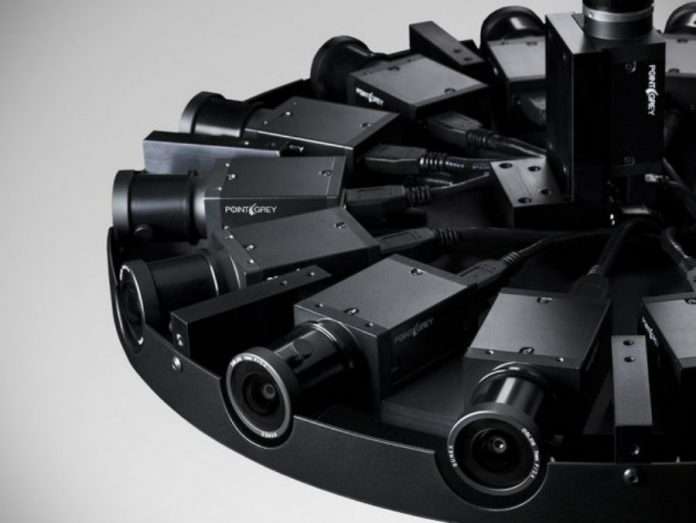
Back in April Facebook (NASDAQ: FB) announced their high quality, production ready 360-degree camera, and they finally released it.
Today Facebook is introducing the Surround 360, although they released it officially the Surround 360 is not going to be produced by Facebook, so they are also releasing the schematics as open source so anyone can build their Surround 360 camera.
All the camera’s design were shared on GitHub today, including the camera’s overall design, assembly instructions, control hardware and more importantly the code that stitches the camera’s images into one seamless 360-degree whole.
According to Facebook’s official blog they have designed a durable camera with the high-end quality video system. This system includes the design used for the camera’s hardware along with all the specifications needed to make it work.
Facebook believes that making the camera open source on Github will help them expand the 3D-360 community, and it will also motivate anyone willing to improve the original design. The 14-eyed Camera system exports video in 4k, 6k and 8k video for each eye. The current industry standard output is 4k, so the Surround doubles it.
Videos filmed by Surround can be played on Gear VR with Facebook’s custom Dynamic Streaming Technology, and it can also be played on Facebook itself.
Facebook also disclosed the company is no ready to stream live 360 videos from people using the social network yet. Tailoring all those videos together to make it a whole 360-degree video takes some time and new technology to reduce that time is not yet here.
The camera designed by Facebook also has a 3D stereoscopic system incorporated that can be used through VR headsets like the Samsung Gear and the Oculus Rift.
Surround 360, a high-quality 3D-360 hardware and software video capture system, is now open source. https://t.co/gTH3Sk3UgF
— Meta Open Source (@MetaOpenSource) July 26, 2016
Other manufacturers like Google and Nokia are also developing these 360 degrees professional cameras, the new GoPro able to record 360 degrees will go for about $15.000 while Nokia’s will go for about $60.000. Facebook is the only one sharing its design, though.
Facebook’s camera is different from any camera designed before and it is also different from others 360-degree cameras on the market. Brian Cabral, Director of Engineering at Facebook said that they built a sturdy camera to withstand capturing videos out in the field while being easy to use.
“The software is more complicated than the hardware. Not all hardware manufacturers can build the right software,” said Shahar Bin-Nun, Ceo of HumanEyes.
Human Eyes is an Israeli company that will also release a new 360-degree camera. He also stated that they have no intention to use the software and hardware from Facebook’s camera, but if the stitching code can be used on cameras different to the Surround 360 they might be interested in it.
The strategy behind releasing all these designs as open source information is that anyone will be able to use them to build something new and to generate more interest in this topic. Even when the stitching code made by Cabral’s team is only meant to upload videos to Facebook, the system can also be modified to upload the data on different services.
Back in April when Cabral’s team began to work on the Surround 360, they described the hardware requirements of the camera.
The cameras used on the Surround 360 are industrial strengthened cameras made by Point Grey. These devices have global shutters which will not overheat even when they are being used for extended periods of time.
The cameras are bolted onto an aluminum chassis, which ensures the that the cameras inside and the right will not move. And an outer shell made of powder-coated steel to protect the internal components from weather and damage.
#Facebook Frees Its #VR Camera to Push #360Video Everywhere – WIRED #VirtualReality #digitalmedia https://t.co/nmAlR9hszu
— tim.i.am (@tim_i_m) July 26, 2016
Facebook also addressed the software concerns about the stitching process, and this process generates the final video image, and since visual image quality was paramount in their concept, they carefully tried to maintain the pixel quality at each step of the computation.
“The key algorithmic element is the concept of optical flow. Our code builds upon an optical flow algorithm that is mathematically trickier than other stitching solutions but delivers better results,” wrote Cabral in Facebook’s official blog.
Cabral spoke about the current engineering challenge that involves making a 360-degree camera. He said that having more cameras will make the subsequent stitching a lot easier, but it will also increase the volume of data and the bandwidth needed to process it. He also says that increasing sensor’s resolution will improve the final rendering, but then again it will increase the data volume and bandwidth required.
The only milestone to be achieved now is to be able to live stream high-fidelity 360-degree video, for now, the internet is not yet ready because there is not enough bandwidth to transfer all that data in real time, but as the web continues to evolve it is inevitable to happen.
Source: The Verge










